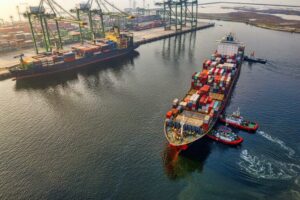Op-ed: New solution addresses historic inefficiencies in maritime operations
The following article is an op-ed piece authored by Nicolas Degorce, Sustainability Project Lead at Bureau Veritas, who explains how the shipping industry can reduce its carbon dioxide emissions now while waiting for other decarbonization techniques to become widely available.

Shipping has a fuel consumption problem. However, in recent years, the industry has introduced a number of comprehensive GHG intensity regulations to mitigate this issue, whilst compelling shipowners to operate on sustainable fuels. Despite this effort, shipping is struggling to implement its decarbonization transition, with sustainable fuels being much more expensive and much less available than their fossil counterparts.
As we approach the first of the International Maritime Organization’s (IMO) check points in 2030 – as outlined in their revised GHG strategy in 2023 – the pressure to evidence meaningful reductions in carbon emissions is increasing.
When it comes to securing shipping’s decarbonized future, the industry has experienced a significant acceleration in the development of energy efficiency and clean technology systems designed specifically to support the mitigation of harmful emissions from maritime operations.
Wind propulsion technology, for instance, has experienced a substantial increase in its integration in recent years. As of February 2025, more than 125 wind propulsion systems have been installed on over 57 ships, in addition to 17 ships that are already prepared for the potential installation of wind propulsion systems. In fact, a recent study suggests that over 1,600 ships will be ordered by 2030, and by 2050, it is estimated that 30% of the entire global fleet will have engaged with wind propulsion technology.
When it comes to making meaningful reductions in shipping’s carbon emissions, the development of alternative fuels – such as methanol, ammonia and hydrogen – are widely regarded as the preeminent means by which the industry will secure a cleaner, more sustainable, future.
However, the pace in development of low and zero-carbon fuel technologies is currently not keeping up with the needs of the industry, in part, due to a lack of investment from shipowners who are reticent to invest at a time when the current viability of alternative fuels is uncertain. Fuel technologies, such as methanol and ammonia, also bring with them a significant risk profile due to their volatile composition, and the increase in e-fuel development is hampered by the lack of onshore infrastructure to support the necessary supply of green electricity. Furthermore, the CAPEX implications, not just of the fuels themselves, but in committing to retrofit and newbuild development to future-proof the global fleet, represent a significant barrier.
In light of this context, it is imperative that operational and technical efficiency measures are combined with energy-saving technologies in the short term, when emissions are at their highest. In 2024, Bureau Veritas Marine & Offshore (BV) released a technical paper focusing on decarbonization trajectories. The paper highlighted the importance of embracing practical solutions such as reducing speed, voyage optimization, weather routing, energy-saving devices, and wind-assisted propulsion, which will all help to drive decarbonization.
BV’s modelling confirmed the potential hefty cumulative impact of operational and technical efficiency measures in keeping shipping within its “GHG budget” to 2050. BV’s simulations show that without action to reduce speed or waiting time while ocean transportation volumes grow moderately to reach a 50% increase by 2050, GHG emissions would be 92% higher in 2050, with 44% more emissions over the period from a GHG budget perspective, than if these levers had been actioned.
In response, BV has been supporting the development of innovative solutions that seek to address current industry inefficiencies, such as “Sail Fast, Then Wait” (SFTW), a practice that involves ships sailing quickly to reach port and then idling at anchorage. To address this unsustainable practice, BV has recently announced the validation of the Blue Visby Solution (BVS) methodology. This multilateral platform, developed by the Blue Visby Consortium, utilizes a unique algorithm to provide participating vessels with optimized arrival times that allow them to slow steam, which can reduce shipping emissions by approximately 15%, and has the potential to remove approximately 45 million tonnes of CO2 across the tanker and bulker fleets, based on 2019 figures. Further benefits of optimizing port arrival times include a reduction in underwater noise pollution, improving air quality outside of ports, as well as dramatically reducing port congestion, which then reduces the risk of collisions.
As part of the validation process, BV assessed BVS methodology’s accuracy, reliability and the various factors that ensure a neutral outcome when considering the financial interests of the participating organizations. In validating the BVS methodology, BV has created the assurance necessary for the solution to be deployed to market, providing a vital tool that will support regulatory compliance efforts, as well as wider decarbonization strategies.
Shipping’s regulatory environment is multifaceted and complex. Following the outcomes from the IMO’s recent MEPC 83 meeting, it is likely that shipping will soon need to adapt to higher fuel costs with an increasing share of sustainable fuels that seek to mitigate the greenhouse gas (GHG) intensity of maritime fuels.
As a result, to mitigate the growth in fuel budgets, the industry is having to rethink the established practices on which it has relied for generations, by engaging with developing clean technologies whilst utilizing emerging solutions that support immediate fuel consumption reduction and emissions savings, in order to ensure ongoing regulatory compliance at better cost.
Read more
- BV: Achieving sustainable blue economy extends beyond decarbonizing shipping
- BV: Regulatory barriers impede widespread uptake of wind propulsion
- SunRui wins BV AiP for its wind propulsion technology
- Bureau Veritas introduces new classification rules for wind propulsion systems
- Op-ed: Sailing towards sustainability








